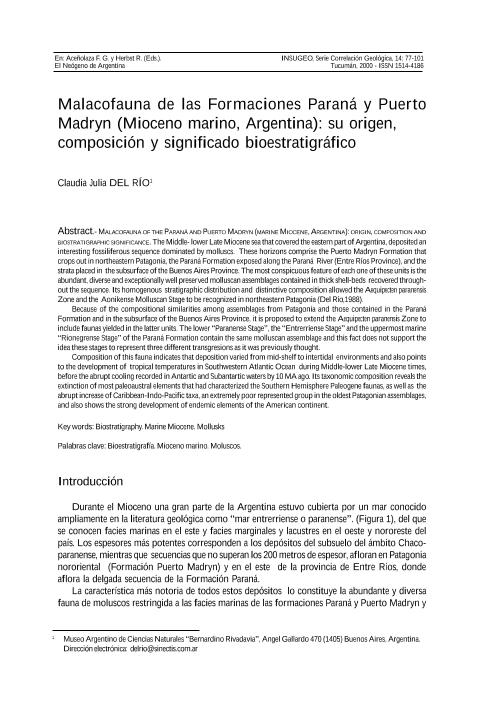Mostrar el registro sencillo del ítem
dc.contributor.author
del Río, Claudia Julia

dc.date.available
2021-07-30T13:05:09Z
dc.date.issued
2000-12
dc.identifier.citation
del Río, Claudia Julia; Malacofaunas de las Formaciones Paraná y Puerto Madryn (Mioceno marino, Argentina): su origen, composición y significado bioestratigráfico; Instituto Superior de Correlación Geológica; Serie Correlación Geológica; 14; 12-2000; 77-101
dc.identifier.issn
1514-4186
dc.identifier.uri
http://hdl.handle.net/11336/137432
dc.description.abstract
The Middle- lower Late Miocene sea that covered the eastern part of Argentina, deposited an interesting fossiliferous sequence dominated by molluscs. These horizons comprise the Puerto Madryn Formation that crops out in northeastern Patagonia, the Paraná Formation exposed along the Paraná River (Entre Ríos Province), and thestrata placed in the subsurface of the Buenos Aires Province. The most conspicuous feature of each one of these units is the abundant, diverse and exceptionally well preserved molluscan assemblages contained in thick shell-beds recovered throughout the sequence. Its homogenous stratigraphic distribution and distinctive composition allowed the Aequipecten paranensisZone and the Aonikense Molluscan Stage to be recognized in northeastern Patagonia (Del Río,1988). Because of the compositional similarities among assemblages from Patagonia and those contained in the Paraná Formation and in the subsurface of the Buenos Aires Province, it is proposed to extend the Aequipecten paranensis Zone to include faunas yielded in the latter units. The lower “Paranense Stage”, the “Entrerriense Stage” and the uppermost marine“Rionegrense Stage” of the Paraná Formation contain the same molluscan assemblage and this fact does not support the idea these stages to represent three different transgresions as it was previously thought. Composition of this fauna indicates that deposition varied from mid-shelf to intertidal environments and also points to the development of tropical temperatures in Southwestern Atlantic Ocean during Middle-lower Late Miocene times, before the abrupt cooling recorded in Antartic and Subantartic waters by 10 MA ago. Its taxonomic composition reveals the extinction of most paleoaustral elements that had characterized the Southern Hemisphere Paleogene faunas, as well as the abrupt increase of Caribbean-Indo-Pacific taxa, an extremely poor represented group in the oldest Patagonian assemblages, and also shows the strong development of endemic elements of the American continent.
dc.format
application/pdf
dc.language.iso
spa
dc.publisher
Instituto Superior de Correlación Geológica
dc.rights
info:eu-repo/semantics/openAccess
dc.rights.uri
https://creativecommons.org/licenses/by-nc-sa/2.5/ar/
dc.subject
Bioestratigrafía
dc.subject
Moluscos
dc.subject
Mioceno marino
dc.subject.classification
Geología

dc.subject.classification
Ciencias de la Tierra y relacionadas con el Medio Ambiente

dc.subject.classification
CIENCIAS NATURALES Y EXACTAS

dc.title
Malacofaunas de las Formaciones Paraná y Puerto Madryn (Mioceno marino, Argentina): su origen, composición y significado bioestratigráfico
dc.title
Malacofauna of the Paraná and Puerto Madryn (marine Miocene, Argentina): origin, composition and biostratigraphic significance
dc.type
info:eu-repo/semantics/article
dc.type
info:ar-repo/semantics/artículo
dc.type
info:eu-repo/semantics/publishedVersion
dc.date.updated
2021-07-12T13:32:27Z
dc.journal.volume
14
dc.journal.pagination
77-101
dc.journal.pais
Argentina

dc.journal.ciudad
Tucumán
dc.description.fil
Fil: del Río, Claudia Julia. Consejo Nacional de Investigaciones Científicas y Técnicas. Oficina de Coordinación Administrativa Parque Centenario. Museo Argentino de Ciencias Naturales "Bernardino Rivadavia"; Argentina
dc.journal.title
Serie Correlación Geológica
dc.relation.alternativeid
info:eu-repo/semantics/altIdentifier/url/http://www.insugeo.org.ar/publicaciones/docs/scg_14/07_Malacofauna.htm
Archivos asociados
